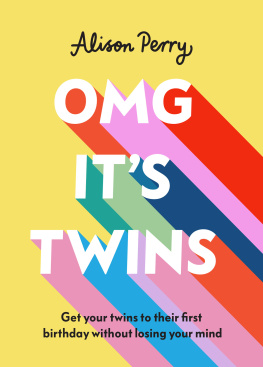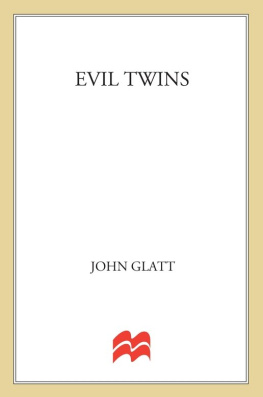Table of Contents
List of tables
- Tables in Chapter 1
List of figures
- Figures in Introduction
- Figures in Chapter 1
- Figures in Chapter 2
- Figures in Chapter 3
- Figures in Chapter 4
- Figures in Chapter 5
- Figures in Chapter 6
- Figures in Chapter 7
- Figures in Chapter 8
- Figures in Chapter 9
- Figures in Chapter 10
- Figures in Chapter 11
- Figures in Chapter 12
- Figures in Chapter 13
- Figures in Appendix 3
Landmarks
Twin Mythconceptions
False Beliefs, Fables, and Facts about Twins
Nancy L. Segal, Ph.D.
Professor of Psychology and Director, Twin Studies Center
California State University
Psychology Department
Fullerton, CA, United States
Table of Contents
Copyright
Academic Press is an imprint of Elsevier
125 London Wall, London EC2Y 5AS, United Kingdom
525 B Street, Suite 1800, San Diego, CA 92101-4495, United States
50 Hampshire Street, 5th Floor, Cambridge, MA 02139, United States
The Boulevard, Langford Lane, Kidlington, Oxford OX5 1GB, United Kingdom
Copyright 2017 Elsevier Inc. All rights reserved.
No part of this publication may be reproduced or transmitted in any form or by any means, electronic or mechanical, including photocopying, recording, or any information storage and retrieval system, without permission in writing from the publisher. Details on how to seek permission, further information about the Publishers permissions policies and our arrangements with organizations such as the Copyright Clearance Center and the Copyright Licensing Agency, can be found at our website: www.elsevier.com/permissions.
This book and the individual contributions contained in it are protected under copyright by the Publisher (other than as may be noted herein).
Notices
Knowledge and best practice in this field are constantly changing. As new research and experience broaden our understanding, changes in research methods, professional practices, or medical treatment may become necessary.
Practitioners and researchers must always rely on their own experience and knowledge in evaluating and using any information, methods, compounds, or experiments described herein. In using such information or methods they should be mindful of their own safety and the safety of others, including parties for whom they have a professional responsibility.
To the fullest extent of the law, neither the Publisher nor the authors, contributors, or editors, assume any liability for any injury and/or damage to persons or property as a matter of products liability, negligence or otherwise, or from any use or operation of any methods, products, instructions, or ideas contained in the material herein.
Library of Congress Cataloging-in-Publication Data
A catalog record for this book is available from the Library of Congress
British Library Cataloguing-in-Publication Data
A catalogue record for this book is available from the British Library
ISBN: 978-0-12-803994-6
For information on all Academic Press publications visit our website at https://www.elsevier.com/books-and-journals

Publisher: Nikki Levy
Acquisition Editor: Nikki Levy
Editorial Project Manager: Barbara Makinster
Production Project Manager: Nicky Carter
Designer: Matthew Limbert
Typeset by Thomson Digital
Identical female twins. Photo credit: Chana Liba Garelick; Photo courtesy: Miriam Cohen
Male-female twin babies: Reprinted by permission. Image source: shutterstock.com/ Veronica Galkina http://www.shutterstock.com/gallery-107404p1.html
Mixed-Race Twins: Reprinted by permission. Image source: Barcroftmedia.com
Dedication
For twins, triplets, and more who do so much for science
just by being themselves
and
To my late parents, Esther and Al Segal, who raised
my twin sister and me with fair-mindedness and foresight
About the Author

Dr. Nancy L. Segal received a BA degree in psychology and literature from Boston University (1973), and MA (1974) and Ph.D. (1982) degrees in the Social Sciences and Behavioral Sciences from the University of Chicago. She is currently a Professor of Psychology at California State University, Fullerton and Director of the Twin Studies Center. She has authored over 200 scientific articles and book chapters, as well as several books on twins.
Dr. Segal has received several international awards, including the James Shields Award for Lifetime Contributions to Twin Research (International Society for Twin Studies) and the International Making a Difference Award (Multiple Births Canada). She is also the 2016 recipient of the Wang Family Excellence Award from California State University. Dr. Segal has contributed to national and international media, including the New York Times and the Washington Post. She has been a frequent guest on national and international television and radio programs, such as the Today Show, Good Morning America , the Martha Stewart Show, the Oprah Winfrey Show, and The Forum (BBC).
Foreword
Francis Galton, Charles Darwins half-cousin, launched the modern study of twins in the late 19th century, but it was not until the late 20th century that geneticists and psychologists developed the tools to analyze the relative influences of nature and nurture (genes and environment) and tease apart the variables that matter most in making us who we are. These sciences are behavior genetics and evolutionary psychology and there is today perhaps no one more knowledgeable on twins and what they can tell us about human nature than Nancy Segal, whose many books on the subject Indivisible by Two, Born TogetherReared Apart, Entwined Lives present her own research and that of other scientists on everything we know about this most revealing natural experiment.
In Twin Mythconceptions , Segal reviews (and where appropriate debunks) the many false beliefs and fables about twins, including the differences between identical and fraternal twins, virtual twins, unrelated look-alikes, twins switched at birth, identical twins raised in separate environments, the genetics and biology of the twinning process, how modern reproductive technologies are changing our perspectives on the twinning process, and such misnomers as twins are alike in every way, that all young twins should be separated on their first day of school (to cement their individual identity), and that twinning does not skip generations, nor is it caused by ingesting the honey from the guira, the green fruit of the Siguaraya tree that is linked to both fertility and multiple births in Cuba! And twins cannot read each others minds through ESP or other psychical powers better than anyone else, which is to say they cant do it at all because no one can.
As an example of what twins can tell us about human nature, consider the question of why people are religious. Is it in our nature to believe in God, join religions, and engage in spiritual practices, or is this something we learn from our parents, peers, and religious leaders?















